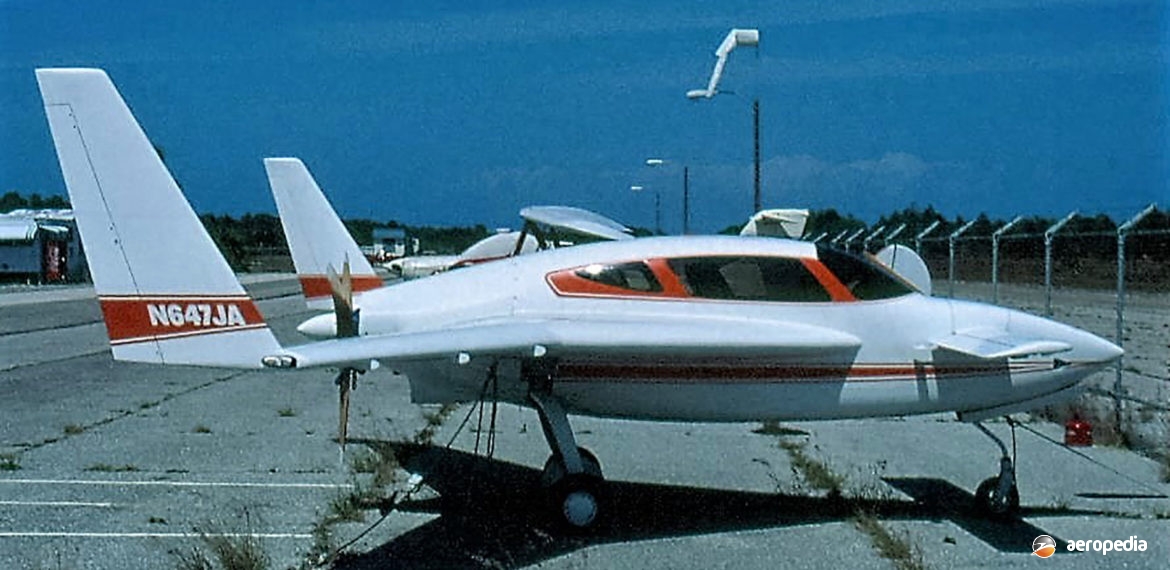Photograph:
Renaissance Composites Berkut N647JA c/n DMO 374) in Florida, USA in April 2001 (David C Eyre)
Country of origin:
United States of America
Description:
Two-seat high-performance light sport aircraft
Power Plant:
One 194 kw (260 hp) Lycoming IO-540 six-cylinder horizontally-opposed air-cooled engine
Specifications:
- Wingspan: 8.25 m (26 ft 8 in)
- Length: 5.67 m (18 ft 6 in)
- Height: 2.29 m (7 ft 6 in)
- Wing area: 33.53 m² (110 sq ft)
- Never exceed speed: 563 km/h (350 mph)
- Max speed: 442 km/h (275 mph)
- Cruising speed: 370 km/h (230 mph)
- Stalling speed: 105 km/h (65 mph)
- Rate of climb: 610 m/min (2,000 ft/min)
- Range: 2,433 km (1,512 miles)
- Fuel capacity (standard): 220 litres (48.4 imp gals)
- Fuel capacity (optional): 280 litres (61.6 imp gals)
- Take-off run: 335 m (1,100 ft)
- Landing run: 338 m (1,110 ft)
- Service ceiling: 7,620 m (25,000 ft)
- Empty weight: 522 kg (1,150 lb)
- Loaded weight: 925 kg (2,100 lb)
- Useful load: 434 kg (965 lb)
History:
Over the years the Berkut has been known by a number of names, depending on the company providing the kits, but these have included Renaissance Composites Inc of Santa Monica, California, USA and Berkut Engineering. Although of similar appearance to the Rutan Long Ez, the Berkut was a new design by David Ronneberg and Kerry Beaufort as part of a business partnership with Donald Murphy in 1989 known as Experimental Aviation. However, the Company closed down in 1992.
The design was later acquired by Renaissance Composites in 1996 but in January 2001 the assets were sold. Berkut Engineering Inc was formed to market the design but this company ceased to market the design in 2002. In 2003 the design was sold to Republic Aerospace but this transfer fell through. In the event at least 75 kits are known to have been supplied and a number have been completed around the world.
The Berkut had a number of major differences from the Long Ez. These included a retractable undercarriage, dual canopies, a moulded fuselage, strake and spar. It carried two in tandem, the pilot in the forward position having all instrumentation and controls, the rear seat being equipped with a side-stick and throttle but no rudder pedals, brakes or instruments. Whereas early kits had wings and canard structurally similar to the Long Ez, later kits had fully moulded fibre canards and wings, leaving only minor fairings and tip surfaces to be carved from foam.
Over the years the undercarriage was re-engineered, some having a hydraulic nose-wheel extension system, but later aircraft having an electro-mechanical jack-screw. The aircraft was designed from the outset for the 134 kw (180 hp) Lycoming IO-360 engine but was re-configured by a number of builders to take the 194 kw (260 hp) Lycoming IO-540. Some reportedly reached speeds of 483 km/h (300 mph) in level flight.
Variants of the design have been the Berkut 360 with a Lycoming O-360 engine; the Berkut FG360 with a fixed undercarriage, which was only ever built as an un-manned aerial vehicle by Geneva Aerospace; the Berkut 540 with the six-cylinder IO-540 engine; the Berkut FG540 fixed undercarriage model; and the Mobius, a modified version with a single cockpit and automatic flight equipment in the rear seat for UAV research. The Berkut Jet was a modified variant built by Jerrold Jorritsma in the US with a modified General Electric T-58 turbine. At least one example is under construction in Australia.

